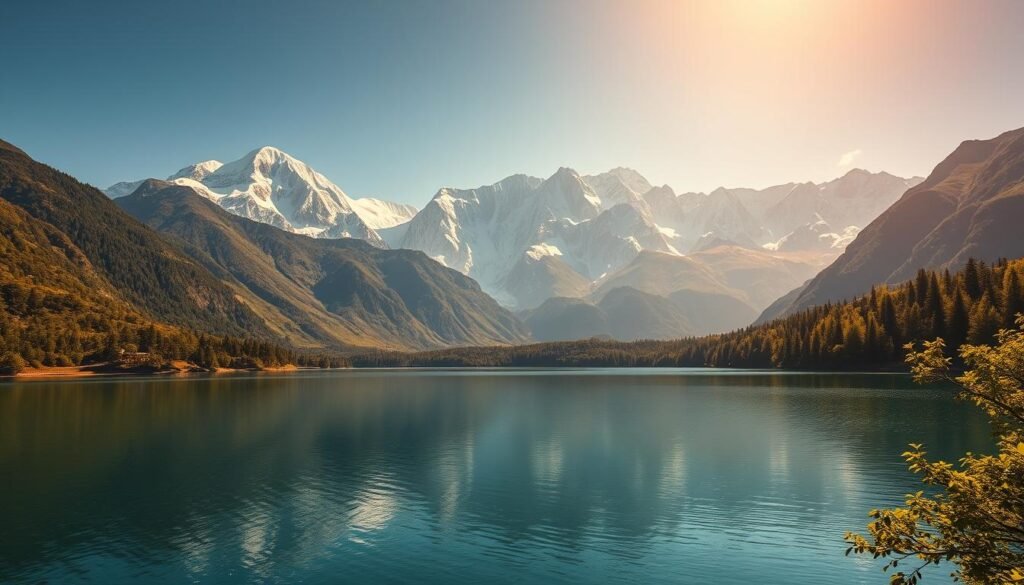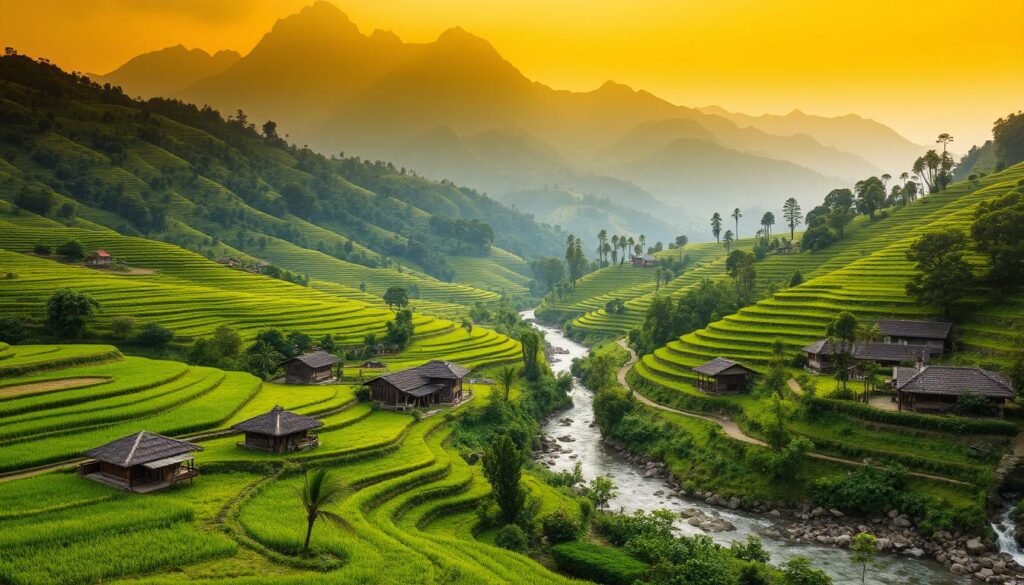Did you know that 83% of India’s breathtaking beauty remains unexplored by mainstream travelers? Beyond the iconic Taj Mahal and Goa’s beaches lies a world of undiscovered places waiting to be explored. In 2025, we invite you to step off the beaten path and uncover the country’s best-kept secrets.
India’s diverse landscapes offer more than just popular tourist spots. From misty valleys to ancient tribal villages, these destinations blend adventure, culture, and untouched nature. Each location tells a story—whether it’s a UNESCO-recognized heritage site or a thriving local tradition.
We’ve curated this list to help you experience India like never before. Get ready for eco-friendly travel, immersive cultural encounters, and landscapes that will leave you speechless. Let’s dive into the magic of these lesser-known wonders.
Why Explore India’s Hidden Gems in 2025?

With new highways and UNESCO recognitions, 2025 unlocks hidden wonders across India. The country’s remote destinations are now more accessible than ever, thanks to upgraded infrastructure and regional air routes. Imagine mist-kissed hills and ancient tribal villages—waiting just beyond the usual tourist trails.
We’re seeing a surge in travelers prioritizing authenticity over crowds. Post-pandemic, sustainable travel trends emphasize eco-friendly stays and immersive cultural exchanges. Places like Ziro Valley and Majuli—now UNESCO-recognized—epitomize this shift.
Key reasons to visit in 2025:
- Improved connectivity: Direct flights to Arunachal Pradesh and Assam’s new highways cut travel time significantly.
- Government initiatives: Northeast tourism receives boosted funding, enhancing local amenities while preserving natural beauty.
- Climate resilience: Unlike crowded hotspots, these destinations offer year-round appeal. Monsoon transforms valleys into emerald paradises, while winter reveals crisp mountain views.
Adventure seekers will love the untouched trails, while culture enthusiasts can dive into thriving tribal traditions. Whether it’s the granite hills of Jawai or the serene monasteries of Tawang, 2025 is your year to discover India’s best-kept secrets.
1. Ziro Valley, Arunachal Pradesh: Where Culture Meets Wilderness

Tucked in Arunachal Pradesh, Ziro Valley blends tribal heritage with untouched landscapes. A UNESCO World Heritage Site candidate, it’s home to the Apatani tribe, known for facial tattoos and sustainable rice-fish farming. Here, misty hills and emerald paddies create a scene straight from a postcard.
How to Reach
Ziro Airport, just 3km away, connects to major cities. For monsoon travel, helicopter services from Itanagar ensure year-round access. New highways make road trips smoother, cutting travel time significantly.
Best Time to Visit
Plan your trip between May and October. This window offers perfect trekking weather and the famed Ziro Music Festival in September. Monsoon transforms the valley into a *lush green* paradise.
Local Culture & Food
The Apatani serve smoked meats and bamboo shoot delicacies. Their integrated rice-fish farms—a UNESCO-recognized practice—showcase eco-friendly innovation. Don’t miss tribal dances during festivals.
Unique Experiences
Hike pine-clad trails to Kile Pakho ridge for panoramic *views*. Explore traditional fish farms or attend the music festival, where indie artists perform against mountain backdrops. Every corner tells a story.
2. Gokarna, Karnataka: Serene Beaches & Spiritual Vibes
Where golden sands meet ancient temples, Gokarna offers a rare blend of tranquility and tradition. This coastal town is a sanctuary for beach lovers and pilgrims alike—its shores less crowded than Goa’s, yet equally stunning. The rhythm here is set by crashing waves and temple chants.
How to Reach
The nearest railhead is Ankola, just 20km away. Road trips from Goa (140km) or Bengaluru (480km) reveal Karnataka’s lush forests and tea estates. For a scenic route, take NH66 along the Konkan coast.
Best Time to Visit
Plan your trip between November and February. These months promise sunny skies, calm seas, and dolphin sightings. Avoid monsoons (June–September) when heavy rains limit beach access.
Local Culture & Food
Gokarna thrives on contrasts—devotees throng the Mahabaleshwar Temple during Mahashivratri, while backpackers unwind at Kudle Beach’s cliffside cafes. Savor coastal Malvani cuisine: try fish koliwada (spicy fried fish) or solkadhi (coconut-kokum drink).
Unique Experiences
- Beach-hopping trail: Walk from Om Beach’s crescent shores to Paradise Beach’s hidden coves.
- Ashtanga yoga retreats: Rejuvenate with sunrise sessions overlooking the Arabian Sea.
- Temple-town charm: Join evening aartis (prayer ceremonies) for a spiritual high.
3. Tawang, Arunachal Pradesh: Monasteries in the Clouds
Perched at 10,000 feet, Tawang’s misty monasteries whisper tales of ancient Buddhist traditions. This Himalayan haven blends spiritual grandeur with adventure—think snow-draped passes and cliffside gompas (monasteries). Home to the 17th-century Tawang Monastery (the world’s second-largest), it’s a place where prayer wheels spin alongside army convoys near the China border.
How to Reach
Foreign travelers need a Protected Area Permit (PAP), obtainable in Guwahati or via tour operators. Fly to Tezpur Airport, then take a 10-hour drive through Sela Pass—a 13,700ft-high spectacle of frozen lakes and wildflowers. Helicopters from Guwahati cut travel time to 90 minutes.
Best Time to Visit
May–October offers sunny weather for trekking. Winter (November–February) transforms Sela Pass into a white wonderland—ideal for photographers but requiring 4WD vehicles. Avoid monsoons (July–September) when landslides disrupt roads.
Local Culture & Food
Butter tea and thukpa (noodle soup) fuel conversations in cozy kitchens. Witness monastic debates at Urgelling Gompa, where monks dissect philosophy with theatrical handclaps. The Apatani tribe’s smoked meats and bamboo shoot curries add earthy flavors.
Unique Experiences
- Bumla Pass: Stand at the India-China border (15,200ft) with armored escorts.
- Monsoon acclimatization: Spend 48 hours in Dirang (4,900ft) to avoid altitude sickness.
- Festival immersion: Join Losar (Tibetan New Year) for masked dances and chang (barley beer).
4. Majuli, Assam: The World’s Largest River Island
Floating like a green jewel on the Brahmaputra, Majuli is a living museum of Assam’s riverine culture. This UNESCO-nominated island—home to Neo-Vaishnavite monasteries and the Mishing tribe—blends spiritual heritage with natural beauty. Erosion shrinks its shores yearly, making every visit a chance to witness a vanishing wonder.
How to Reach
Ferries from Jorhat (20km) offer a scenic 1-hour river crossing—pack light for the wooden boats. For speed, fly to Jorhat Airport and hire a taxi to Nimati Ghat. Helicopters from Guwahati (3 weekly) save time but lack the Brahmaputra’s magic.
Best Time to Visit
November–March delivers sunny days perfect for exploring. Time your trip with Raas Leela (November), when monks perform Krishna’s tales in ornate masks. Monsoons (June–September) flood bicycle trails but reveal the island’s lush peak.
Local Culture & Food
Satras (monastic centers) teach mask-making using bamboo and clay. Try komal saul (organic rice) with smoked fish at Mishing stilt houses. These river-facing homes showcase indigenous flood-resistant architecture.
Unique Experiences
- Pottery trail: Bike between villages crafting terracotta without wheels—only hand-molding.
- Sunset at Kamalabari Satra: Watch monks paint masks under mango trees.
- Eco-farming demo: Learn how rice grows in waterlogged fields, sustaining the island for centuries.
Majuli isn’t just a destination—it’s a masterclass in resilience. From dance-dramas to disappearing shorelines, this island demands to be seen now.
5. Chitrakote Falls, Chhattisgarh: India’s Niagara
Thundering over red cliffs, Chitrakote Falls earns its nickname as India’s Niagara with a 98ft cascade. This horseshoe-shaped wonder on the Indravati River showcases the raw beauty of Chhattisgarh’s wild heart. Few places blend such power with accessibility—just 38km from Jagdalpur.
How to Reach
Jagdalpur Airport (50km away) connects via daily flights from Raipur. Road trips through Bastar’s tribal villages reveal vibrant murals and weekly haats (markets). Foreign tourists need a permit for tribal areas—apply online or at Raipur’s SDM office.
Best Time to Visit
The ideal time visit depends on your preference. July–October unleashes the falls’ full might, while November–February offers tranquil views and easier trails. Winter mornings often gift rainbows in the mist.
Local Culture & Food
Bastar’s Dhokra metal artisans craft intricate figurines—visit workshops near Barsoor. Try chapura chutney (red ant paste), a tangy tribal delicacy. During Dussehra, the 75-day festival transforms Jagdalpur into a cultural epicenter.
Unique Experiences
- Moonlit magic: Visit during a full moon to see the falls glow silver.
- Waterfall circuit: Pair Chitrakote with Tirathgarh Falls’ tiered cascades.
- Tribal immersion: Stay in Mishing stilt houses to learn flood-resistant architecture.
Chitrakote isn’t just a waterfall—it’s a gateway to Bastar’s untamed landscapes and living heritage. From monsoon thunder to winter serenity, every season rewrites the experience.
6. Jawai, Rajasthan: Leopards & Granite Hills
Granite hills rise like sentinels in Jawai, where leopards roam freely under Rajasthan’s golden skies. This untamed region blends desert beauty with thriving predator populations—offering safari experiences unlike any other national park in India. Here, the Rabari tribe’s pastoral traditions add cultural depth to the rugged landscape.
How to Reach
Jawai is 140km from Udaipur Airport. Drive through Pali District’s scrub forests, where roadside chai stalls serve spicy mirchi vadas. For a scenic route, take NH58 via Sadri—watch for peacocks crossing the road.
Best Time to Visit
November–March is ideal for leopard sightings. Winter migratory birds flock to Jawai Bandh, while summer (April–June) reveals predators near waterholes. Monsoons (July–September) transform the hills into emerald oases.
Local Culture & Food
The Rabari people—recognizable by their white turbans—craft intricate embroidered shawls. Try laal maas (spicy mutton curry) at Bera village homestays. Evenings often feature folk songs about camel herders under starry skies.
Unique Experiences
- Night safaris: Follow strict no-flash rules to spot leopards hunting by moonlight.
- Granite photography: Sunrise at Kambeshwar Mahadev Temple offers panoramic views of boulder-strewn hills.
- Rabari workshops: Learn embroidery stitches passed down for generations.
Jawai isn’t just a destination—it’s where wilderness and culture collide. From leopard tracks to tribal tales, every moment here feels like a discovery.
7. Rinchenpong, Sikkim: Silent Peaks & Ancient Monasteries
Nestled in the Himalayas, Rinchenpong offers silent peaks and spiritual serenity. This hill station is a sanctuary for those seeking untouched landscapes and cultural depth. From 360° views at Rinchenpong Monastery to Sikkim’s only tea estate, every corner tells a story.
How to Reach
Shared taxis from Bagdogra Airport (120km) wind through misty roads, passing cardamom farms. For a scenic route, take the Jorethang-Rinchenpong highway—stop at Tashiding Monastery en route. Helicopters from Gangtok are available but lack the road trip’s charm.
Best Time to Visit
April is magical, with Rhododendron blooms painting the hills red. For clear weather, visit October-November. Monsoons (June-September) bring lush greenery but slippery trails.
Local Culture & Food
The Lepcha tribe’s organic farms showcase sustainable practices. Try *momo* dumplings stuffed with local cheese or nettle soup. Evenings often feature folk tales about Mount Kanchenjunga—considered a deity here.
Unique Experiences
- Temi Tea Garden: Sip golden liquor from Sikkim’s sole tea estate.
- Monastery sunrise: Watch dawn light up Kanchenjunga from Rinchenpong Monastery.
- Lepcha workshops: Learn organic farming using ancient techniques.
| Trek Route | Duration | Highlights |
|---|---|---|
| Rinchenpong to Kanchenjunga Viewpoint | 4 hours | Panoramic Himalayan vistas, rare birds |
| Temi Tea Garden Trail | 2 hours | Rolling hills, tea plucking demos |
Rinchenpong isn’t just a place—it’s where mountains meet mindfulness. Whether sipping tea or trekking sacred trails, this hill station stays with you long after you leave.
8. Practical Tips for Exploring India’s Hidden Gems
Exploring India’s lesser-known treasures requires smart planning—here’s how to do it right. Whether you’re trekking in the Himalayas or navigating tribal villages, these tips ensure a smooth travel experience.
Permits & Regulations
Some regions demand special permits. Arunachal Pradesh and Sikkim require Protected Area Permits (PAP), while Inner Line Permits (ILP) apply to Nagaland and Mizoram. Apply online or via tour operators at least 15 days before your trip.
- Altitude readiness: Carry Diamox for high-elevation destinations like Tawang.
- Plastic bans: Himachal and Sikkim enforce strict rules—pack biodegradable toiletries.
- Emergency protocols: Save local helpline numbers and embassy contacts.
Packing Essentials
Pack for versatility. Mountain weather shifts rapidly, and coastal areas demand quick-dry clothing. Here’s what to include:
- Layered clothing: Lightweight thermals for chilly mornings.
- Sturdy footwear: Waterproof hiking boots for rocky trails.
- Power backups: Portable chargers—many locations lack electricity.
Sustainable Travel
Respect the culture and environment. Opt for community-owned homestays in Meghalaya or Assam. Avoid buying tribal crafts made from endangered materials. Instead, support local artisans through ethical souvenirs like handwoven shawls or bamboo products.
Leave no trace. Carry reusable water bottles and avoid single-use plastics. Your choices help preserve these experiences for future travelers.
Ready to Discover India’s Best-Kept Secrets?
The clock is ticking—these untouched landscapes won’t stay secret forever. We’ve mapped a 2025 seasonal calendar to match monsoon treks with festival dates. Expert-guided tours decode tribal traditions, from Apatani rice farms to Lepcha weaving techniques.
Choose sustainable travel with carbon-offset homestays. Emerging digital nomad visas let you work amid Himalayan beauty. Download our tribal artisan directory—each purchase supports living heritage.
This is your time to trade crowds for connection. Whether chasing leopard views in Jawai or meditating in Rinchenpong, the world beyond guidebooks awaits. Let’s explore responsibly—adventure thrives where respect leads the way.




